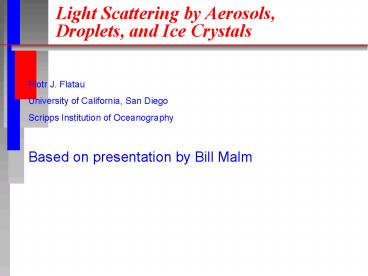Light Scattering by Aerosols, Droplets, and Ice Crystals - PowerPoint PPT Presentation
1 / 21
Title:
Light Scattering by Aerosols, Droplets, and Ice Crystals
Description:
Based on presentation by Bill Malm. Light Scattering by Aerosols, Droplets, and Ice Crystals ... Basis for climate estimates of interaction of radiation with ... – PowerPoint PPT presentation
Number of Views:78
Avg rating:3.0/5.0
Title: Light Scattering by Aerosols, Droplets, and Ice Crystals
1
Light Scattering by Aerosols, Droplets, and Ice
Crystals
Piotr J. Flatau University of California, San
Diego Scripps Institution of Oceanography Based
on presentation by Bill Malm
2
Why light extinction?
- Basis for majority of remote sensing techniques
passive and active. Retrievals of water vapor,
cloud water, temperature soundings - Basis for climate estimates of interaction of
radiation with our atmosphere
3
Optical phenomena Concepts of Geometric Optics
and Monte Carlo
- Ray-tracing (geometric optics)
- Monte-Carlo simulations of many photons
interacting with particles this is what nature
does.
4
(No Transcript)
5
Aerosol transport
- Sulphate conversion
- Transport
6
Size Comparison
Animation cyclone
7
Electromagnetic Spectrum
8
Pollutant Species
9
Particle Size Distribution
10
Basic Interactions of Solar Radiation with
Aerosols
- Extinction
- Scattering (deflection of light)
- Absorption conversion to heat
- Animaton (interactions)
- Animation (scattering)
11
Extinction
The extinction coefficient is made up of particle
and gas scattering and absorption where s, a,
g, and p refer to scattering, absorption, gases,
and particles, respectively.
12
Extinction as Function of Size
where Ee is mass extinction efficiency, f i(x) is
the aerosol mass distribution dm/dx of the ith
species, xlnD/Do, and ? is the wavelength.
13
Scattering Efficiency (Q)
14
Scattering Efficiency as Function of Size
15
Carbon Extinction Efficiency
16
Phase Function for Soil and Sulfate
17
Forward and Backward Scattering
18
Phase Function for Carbon
19
Animations
Animations (size)
20
Components of Scattering and Extinction
21
Summary
- Interaction of light with matter forms basis for
estimation of climate-radiation feedbacks and
remote sensing. - Single scattering albedo, and phase function are
the most important radiative characteristics of a
particle.































